Great Destinations: The Italian Influence on Corsica


This mountainous Mediterranean island is today one of the 13 regions of Metropolitan France, though its culture is more Italian than French, and its sense of otherness is strong. Guy Hibbert learns about its past and discovers that there is much more to do here than sit on a beach
From the dramatic footpath that meanders along the clifftops near Bonifacio, on the southernmost tip of the French island of Corsica, you have a clear view of another island. That island is Sardinia, Corsica’s neighbour, which belongs to Italy. In the town of Bonifacio itself, the street names look more Italian than French, people speak a dialect of Italian known as Corsu, and there are pizza and ice-cream vendors everywhere. You could be forgiven for concluding that Corsica is a simple amalgam of France and Italy.

Looking over Piantarella beach and its crystalline water in Corsica’s far southeast. Photo: Salina Boukhezar
But, as ever, it’s more complicated than that – and Corsican pride insists that you understand more of the story behind this patriotic island nation. During a perfectly sunny week in early May, I was able to start building a picture of the unique Île de Beauté and experience its fascinating history and culture, visiting all four points of the compass and journeying from sunny turquoise bays to wild mountain peaks.
Look at a map and you will immediately notice that Corsica sits in a highly strategic location. To the east is Rome, while to the north lie Pisa and Genoa –
both once very powerful city-states. Corsica is also the first landfall after you leave the harbours of Toulon and Nice in the south of France, while to the south, beyond Sardinia, is North Africa.
It comes as no surprise, then, to hear of Corsica’s importance to the Carthaginians, the Greeks, the Etruscans, the Romans, and to all manner of raiders, invaders and settlers. In the 11th century, it was colonised by the Republic of Pisa before being taken over by the Republic of Genoa in the 13th, whose control of the island lasted until Corsica became part of France in the 18th century.
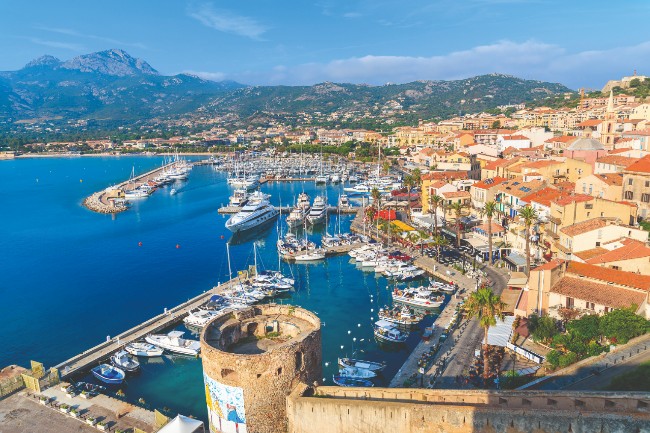
Calvi, the siege of which cost Horatio Nelson the sight
in his right eye. Photo: Shutterstock
GENOESE RULE
The Romans had brought Latin, and the Pisans were the first to bring the Italian language and culture to Corsica, but it was the 500 years of Genoese rule that really consolidated its Italian influence. Yet throughout it all, these proud island people yearned to throw off the shackles of colonial oppression. And in the 18th century that yearning found political expression.
The man remembered for embodying the spirit of independence is Pasquale Paoli, a military leader now known as the ‘Father of the Nation’. He declared the island an independent republic in 1755 and created its founding constitution.
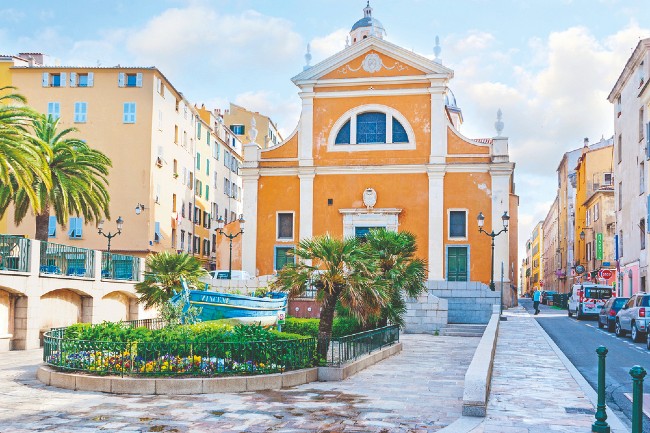
The Cathedral of Our Lady of the Assumption, Ajaccio. Photo: Shutterstock
He also revived the famous symbol of the island, the Moor’s Head – which you may first see painted on the tail fins of Air Corsica planes. But the brief flame of independence was snuffed out within two decades when the island was sneakily sold by the Genoese to the French and General Paoli’s revolutionary army was defeated.
In Corsica you will hear Paoli’s name a lot, but abroad the island is renowned for a far more internationally influential leader, born in Ajaccio in 1769. His name was Napoleon Bonaparte.

Napoleon Bonaparte’s statue in place du Maréchal-Foch, Ajaccio, the town in which he was born. Photo: Shutterstock
AMBIVALENT RELATIONSHIP
Corsicans have an ambivalent relationship with Napoleon. They admire his early years, when he was fiercely loyal to Paoli’s cause, and they acknowledge what he achieved for France. Yet, they also remember how he later fell out with Paoli and went on to forsake Corsican nationalism.
Napoleon is, of course, buried in Paris. He had infamously put Ajaccio fourth on the list of places he wanted to be laid to rest. Nevertheless, he was Corsican – and this year of course is the 250th anniversary of his birth. The celebrations were loudest in Ajaccio, but the date was marked across the island.
As well as being the birthplace of the island’s most famous son, Ajaccio is also the modern capital of Corsica, and home to its biggest airport (Aéroport Ajaccio-Napoléon-Bonaparte), and to a busy ferry port that is increasingly becoming a destination for cruise ships. So it’s a natural starting point for any visitor, and is also worth exploring in its own right.

Holidaymakers enjoying Saint-François beach in Ajaccio, in front of the citadel that was once an important military stronghold. Photo: Shutterstock
The old town has a feel of Nice, with its palm trees and Italianate architecture of pastel-coloured buildings and its ‘English quarter’ (it was a popular Belle Époque winter vacation destination). There’s a thriving market in the place du Maréchal-Foch, and a quick stroll brings you to the impressive citadel, which overlooks two glorious expanses of emerald coastline with beaches and bays stretching in both directions. And Ajaccio’s Fesch Museum houses a collection of 14th- to 18th century Italian paintings that is second in France only to that of the Louvre.
In Corsica, you are never far from majestic scenery, and this is true even of its capital city. The nearby Route des Sanguinaires takes us to the presqu’île de la Parata, where we enjoy a short hike to the dramatic seascape of the peninsula. Nearby is the white sand and blue water of Capo di Feno beach, where you can watch the surfers try their luck as the offshore easterly winds whip up the waves.
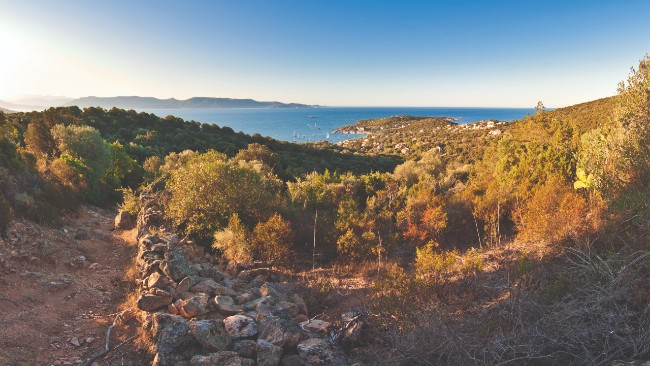
Porto Pollo, “the real Corsica”. Photo: Shutterstock
Heading south from here, we wind our way along ever smaller roads, wondering if these are the kinds of driving conditions we can expect all week. Arriving slightly car-lagged at our next destination, Porto Pollo, our host tells us with pride: “This is the real Corsica.” By this, I suspect she means unspoiled by tourism, wilder and more remote. A small harbour has been created, and a few holiday homes and seaside cafés overlook yet more pristine beaches.
Corsica gets busy in summer, so take note: if you really want to get away from it all, head this way – a ferry will take you from Marseille to the town of Propriano, across the bay from Porto Pollo. But you still won’t be the first people to discover the area: that honour goes to the Neolithic tribes who inhabited the hills and valleys inland from this coastline. And a 15-minute drive from here brings you to Filitosa, perhaps the most impressive of several prehistoric settlements on the island.
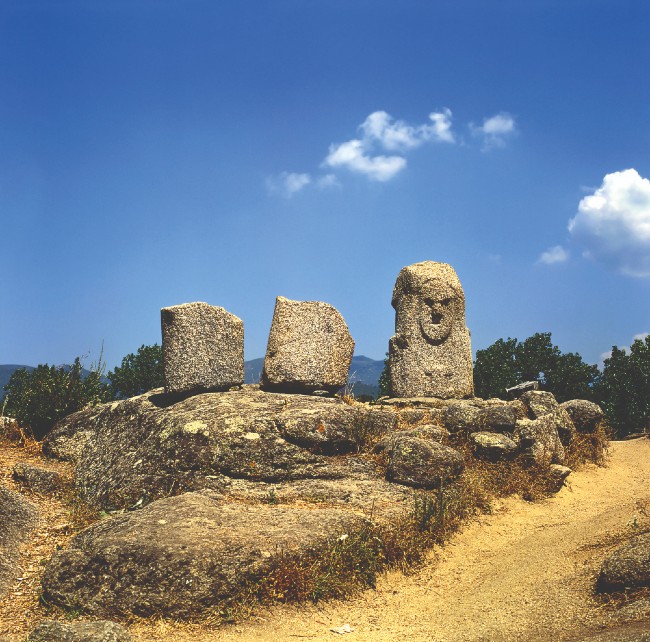
The prehistoric statue- menhirs of Filitosa have become a major inland tourist attraction. Photo: Shutterstock
ANCIENT SETTLEMENT
In 1946, aspiring horse-breeder Charles-Antoine Cesari discovered some remarkable stone structures hidden on a natural spur between two valleys on his land. With the help of archaeologists, a complete settlement of homes and statue-menhirs (sculpted standing stones) dating back to 6000BC was brought to light.
Talking to Cesari’s grandson, who is the director of the site today, we learn about the preservation of the sculptures, the creation of an educational site, and the new museum (due to open soon).
On a warm morning in early summer, before most visitors have arrived, this is a truly magical place: the hills are dotted with ancient olive trees and criss- crossed with footpaths through clusters of primitive stone buildings in meadows laced with wildflowers and valleys where rivulets are edged with beds of irises.

Wild pigs asleep at roadside. Photo: Guy Hibbert
Enthusiasts of prehistory should also make a beeline for the Musée de l’Alta Rocca at Levie for a peek at La Dame de Bonifacio, the oldest human skeleton to have been found on the island (she lived in around 6,750 BC). Castellu di Capula and Castellu di Cucuruzzu have prehistoric forts, and there are numerous other sites to be explored too.
Many thousands of visitors come to Corsica every summer in search of the perfect beach, but they are in danger of missing the charms inland. In order to entice holidaymakers to experience the interior of the island, the Agence du Tourisme de la Corse has created a Route des Sens, a ‘route of the senses’, to help them discover more of the natural beauty and traditional culture of the island beyond its indisputably gorgeous coastline. The Route of the Senses guides you to the ateliers of numerous artisans and craftspeople, and introduces you to a staggering wealth and variety of producers – citrus, honey, aromatic herb and chestnut farmers, winemakers, cheesemakers, olive oil millers, jam-makers…
There is great pride in bio (organic) production in Corsica and even in the larger hotels you will find local bio jams made with ingredients like fig and clementine alongside natural yoghurts on the breakfast table.

These days Corte thrives as a hub for hikers and adventure sports enthusiasts. Photo: Shutterstock
UNIVERSITY TOWN
In the centre of the island is the ancient university town of Corte. This was the capital of Corsica during its brief flowering of independence under Pasquale Paoli, and his statue proudly overlooks the square that is named after him. On another of the town’s squares is a statue of Jean-Pierre Gaffory, Paoli’s predecessor as chef de la résistance, who was assassinated here in 1753. In Corte, you are never far from reminders of the island’s brief independence.
Tucked in the lee of protective mountains, Corte lies at the head of a valley where two fast-flowing rivers, the Restonica and the Tavignano, meet. The cobbled streets of the old town are rustic and picturesque as they ramble gradually up to the citadel, where the views across the two valleys are impressive. It is easy to understand why hikers and river-sports enthusiasts gather here to take on the various kayaking, canyoning and white-water rafting challenges that the interior of the island has to offer.

A shop in Corte. The islanders are proud of their “produits corses.” Photo: Guy Hibbert
Our next destination is Bonifacio, to behold that view over the water to neighbouring Sardinia. The only snag is that to get there our itinerary takes us across the central mountains of the Alta Rocca. Luckily, the road surfaces are better than we expected and, apart from the occasional endurance cyclist, we encounter little traffic.
But it’s obvious we are heading higher and higher. Our ears start to pop as the scenery becomes more dramatic. We leave behind the Mediterranean maquis and start to enter an area of more alpine flora. Up ahead we glimpse the Aiguilles de Bavella, jagged peaks that rise to over 1,800 metres.

The town of Cozzano. Photo: ATC/ S.Alessandri
Then, suddenly, at Ospedale, our route emerges from the mountains and a spectacular vista of the entire east coast is laid out in front of us. This is the great appeal of Corsica: the extraordinary diversity of the landscape on a relatively small island. Only halfway through our tour, we have enjoyed the buzz of a port city, sunbathed on stunning beaches, strolled through millennium-old olive groves and been amazed by quasi-alpine scenery.
Another aspect of this unique diversity is historical and cultural: the way the language, customs and beliefs are woven from the threads of Italian, French and native histories.

A beach in Bonifacio. Corsica has many fine beaches, but so much else to offer besides. Photo: Dumé Azzena
The Italian influence is at its strongest in Bonifacio. And aboard one of the numerous boat tours that depart from the harbour it’s easy to see why this location was identified centuries ago as a good site for a fortress.
The Genoese built what would become a citadel here, around a deep-water port protected by cliffs. Along the coast our captain steers us into caves and calanques, past the lighthouse with the tiny Madonna statue protecting the sailors and finally across the bay to admire the limestone cliffs upon which the old town of Bonifacio is perched. This is the heart of the International Marine Park, rich with rare and protected species such as puffins and sea eagles.

Picturesque scenery of fortress in Corte. Photo: Shutterstock
DAUNTING DETOUR
For our last outing we head upwards from Marina di Porto, a charming port and beach surrounded by steep mountains on the west side of the island, via a daunting detour, back to Ajaccio via Évisa and Vico. This is not a route for nervous drivers, nor anyone afflicted by vertigo; yet the roads are in good condition and the scenery is utterly spectacular. The red stone massifs rise precipitously on either side, sometimes with rocky outcrops overhanging bends in the road, or traversing gorges on old, arched stone bridges. Buzzards and red kites soar overhead. On the mountainside verge along our route is a constant swathe of wild colour – yellow broom, lavender, white and pink rock-roses and foxgloves. And this sense of being in the remote mountain wilderness only increases as we spot cattle, goats or families of wild pigs meandering along roadside paths and sunbathing on the warm surfaces.
Returning to “civilisation” in Ajaccio is such a contrast that it only confirms the extraordinary wealth of landscapes Corsica is blessed with. It would take time to discover the island properly – a week hardly does it justice – and would certainly be worth the effort for the many surprises it still holds.
Sure, you can get a cheap flight and lie on any of its wonderful golden-sand beaches, but somehow that would be missing the point.
From France Today magazine

Traditional boats in Bastia port. Photo: Shutterstock
Share to: Facebook Twitter LinkedIn Email
By Guy Hibbert
Leave a reply
Your email address will not be published. Required fields are marked *

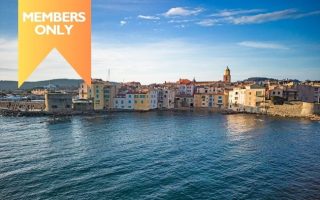


REPLY